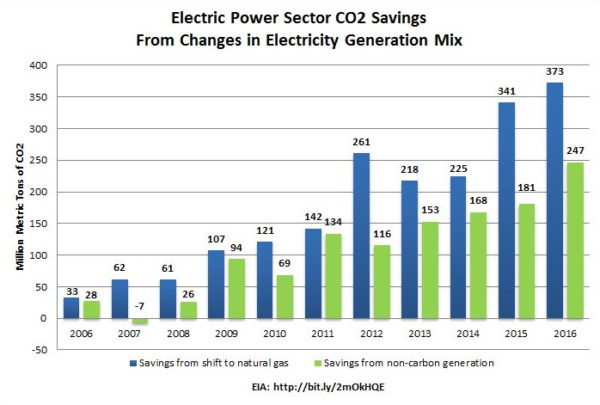Carbon Brief, a United Kingdom-based website focused on covering climate change issues, recently took an in-depth look into why the United States has been able to reduce energy-related carbon emissions by 14 percent since 2005. Not surprisingly, the group concluded:
“Increases in [natural] gas electricity generation is the largest driver, accounting for 33% of the total emissions reduction in 2016.”
If this sounds familiar, it’s probably because it’s a conclusion shared by a number of independent experts, including the Intergovernmental Panel on Climate Change (IPCC), International Energy Agency (IEA) and the U.S. Energy Information Administration (EIA).
And interestingly, the Carbon Brief analysis also found energy-related CO2 emissions are 18 percent lower than they would have been had “underlying factors,” such as increased natural gas use made possible by the shale revolution, never materialized between 2005 and 2016. In other words, Carbon Brief’s “business as usual” scenario found that CO2 emissions would have continued to increase if not for several factors — the most notable being a spike in natural gas consumption, as the following graphic from the report illustrates.
Moreover, Carbon Brief notes the upward trend in carbon emissions found in a “business as usual” scenario would have been driven by electricity generation:
“Without the effects of gas, wind and reduced electricity use, CO2 emissions from the sector could have been expected to continue increasing in line with past trends. By 2016, electricity sector CO2 emissions would then have been almost 46% higher than they are today.”
But of course, it has been anything but “business as usual” since the shale revolution took hold shortly after 2005. Electricity generation emission reductions are clearly the driver of the overall downward trend in CO2 emissions in the U.S. since 2005, as natural gas’ share of the U.S. electricity generation fuel mix has grown from 21 percent to 34 percent during that timespan. That’s thanks in large part to record production and affordable natural gas made possible by fracking.
The Carbon Brief report echoes recent EIA data, finding that electricity generation carbon reductions attributable to natural gas have also far outpaced those from renewables since 2005,
“Coal-to-gas switching is the largest driver of electricity sector CO2 emission reductions, accounting for 45% of the total in 2016. Wind and reduced electricity use each account for around 25%, while solar contributed the remaining 5%.”
In fact, Carbon Brief’s estimates of electricity generation CO2 reductions attributable to natural gas, wind and solar are nearly identical to those from the EIA, illustrated in the following chart.
This latest confirmation of natural gas’ lead role in U.S. carbon reductions is a testament to the effectiveness of our “all of the above,” market-driven approach to reducing greenhouse gas emissions over the past decade. For comparison, the U.S. is outpacing countries such as Germany in GHG reductions, as Germany has actually seen its carbon emissions increase slightly since instituting a renewables-focused energy policy in 2009.
Even more impressively, the Carbon Brief report notes that U.S. carbon reductions have come while the economy has grown significantly,
“Declines in US CO2 have persisted despite an economic recovery from the financial crisis.”
As the following EID chart illustrates, the U.S. has enjoyed substantial gross domestic product (GDP) growth and reduced CO2 emissions since the shale revolution began, an unprecedented trend in modern history.
Fracking opponents have suggested these carbon reductions were more attributable to the economic slowdown during the Great Recession than increased natural gas use made possible by the shale revolution, but Carbon Brief finds such is not the case,
“Emissions continued to fall as the US economy recovered from the financial crisis and associated recession, suggesting this was not the main cause of emission reductions…”
Not surprisingly, considering it is funded by the European Climate Foundation, Carbon Brief does discuss concerns about methane emissions from oil and gas development,
“While official inventories suggest that methane emissions from energy have decreased during the US shale boom, other studies show emissions could be much larger. This would offset a portion of the CO2 benefit of switching from coal to gas, at least in the short term.”
However, the study Carbon Brief hyperlinks to as its example of “other studies” that “show emissions could be much larger” emphasizes that natural gas still delivers “robust climate benefits” when used for power generation. And one of the study’s authors, Francis O’Sullivan, was also quoted in an MIT News interview saying that, “the shift to natural gas is still a positive move for climate-change-mitigation efforts.”
Indeed, numerous studies agree that natural gas system leakage rates are well below the 3.2 percent threshold for natural gas to maintain its climate benefits, dispelling the anti-fracking activist claim that methane leaks wipe out natural gas’ climate benefits.
And not only are we reducing carbon emissions while growing our economy, the latest EPA Greenhouse Gas Inventory shows oil and gas system methane emissions have also decreased significantly in recent years at the same time oil and gas production has skyrocketed.
With record natural gas production forecasted for 2018, the U.S. is poised to continue enjoying the unprecedented trend of carbon reductions and economic growth that has already been well documented — and was further confirmed by this Carbon Brief report.